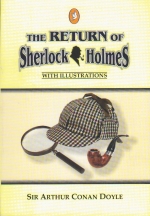

Holmes even lives – which is truly the sign of cultural reach – in long-circulated jokes with punchlines such as "Alimentary, my dear Watson", "Sedimentary, my dear Watson" and "Lemon-entry, my dear Watson". As the film director Michael Powell observed, it was Paget's drawings, as "much as the text" that "created the immortal folk figure". The magnifying glass is Conan Doyle's, but the deerstalker hat was a creation of the Strand magazine's illustrator Sidney Paget. As any fule kno, he never said "Elementary, my dear Watson". Indeed, many of his best known appurtenances are completely absent from those stories. He escaped the confines of his stories, just as he escaped his exasperated creator's attempt to kill him off.

That sort of porosity is the defining characteristic of myth – and Holmes did indeed almost instantly become a myth. And it isn't just with respect to London that Conan Doyle's creation proved porous to the imaginations of others. But this is as much due to Basil Rathbone's set-dressers and the prose of Charles Dickens as to the prose of Conan Doyle. It's true that when we think of Holmes – as well as funny hats, dressing-gowns, pipes, violins, scary dogs and "a 7% solution of cocaine" – we think of gaslight and gloaming, tendrils of fog, the impatient rap of cane on cobblestones, horses whinnying and hansoms clattering. To move Holmes around the capital, Conan Doyle used contemporary street atlases and the London Post Office Directory – the closest thing to Google Maps at the time. Conan Doyle grew up in Edinburgh, was educated in Lancashire and Austria, and lived in central London for less than a year before moving first to South Norwood, then in short order to Hindhead in Surrey and later to Sussex. London is often described as another character in the stories.īut, as historian David Cannadine points out in a fine, sceptical essay in a new book accompanying the exhibition, Holmes's London is actually only sketchily imagined in the stories. In the form of his "Baker Street Irregulars", he even employed a street-level spy-network of urchins. Holmes occupied perhaps London's most famous imaginary address – 221B Baker Street – and Dr Watson wrote that his "knowledge of the byways of London was extraordinary". It is apt that the show should take place at the Museum of London. But you can see what they are getting at. It's a winningly daft title: there are an infinite number of men who never lived and will never die, and a very large number of fictional creations of whom the same could also be said.

Sherlock Holmes: The Man Who Never Lived And Will Never Die is the first major show dedicated to the great detective since a Holmes display graced the Festival of Britain in 1951.


 0 kommentar(er)
0 kommentar(er)
